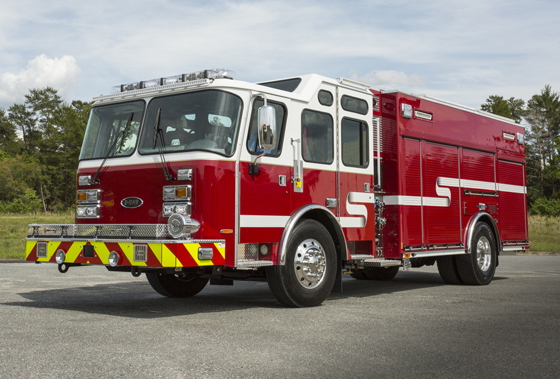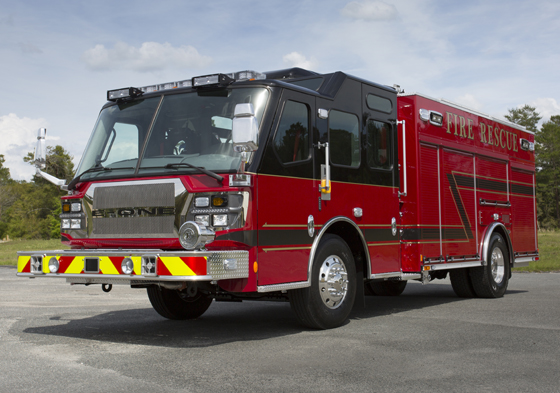
CLICK ABOVE FOR A CYCLONE HS GALLERY >>
By Chris Mc Loone
The really big news E-ONE was keeping close to its vest before FDIC International 2015 is the introduction of a completely new E-ONE product: the HS Series. A group of fire service media representatives was able to get a sneak peak at the new rig and take the truck for a spin as well. According to Jay Johnson, vice president of sales and product management, “Thirty years ago, E-ONE introduced a very innovative product, branded ‘Hush,’ that was engineered around a very specific engine package and pump with gearbox that actually became significant constraints or limitations because of their respective availability and customer preference. E-ONE learned a tremendous amount from the product history and was able to leverage that experience as well as new technologies to engineer a completely new chassis with multiple cab style options as well as a completely new body design.” That product is the HS Series. Johnson was careful to note that E-ONE does not call it a Hush. “It is not a Hush,” he says. “It is absolutely from the ground up a brand new design. The only thing that’s somewhat a Hush is the fact that the engine’s in the rear. Everything else has been newly engineered.”
“A year or so ago, there were some discussions that concluded that we have a different way to do this,” says Joe Hedges, aerial and chassis product manager. “We can reinvent this and produce a much better product.” Hedges states that with the Hush, there was a really short, compact engine. But as engines evolved, the dynamics of the truck changed. “So, the team went to work and figured out a way to package the engine much more efficiently, develop a reduced overhang in the back, and achieve a better balance to the truck.” So, what E-ONE did was take an ISL 450 with EVS transmission and positioned it pretty much over the rear axle, according to Hedges. The E-ONE team configured a very low-profile radiator package to try to keep the hosebed as low as possible. And, it also was very cognizant of ensuring the vehicle’s serviceability.
“When developing this product, we had to make certain that we kept an appropriate focus on two key constituents: the fire service and fleet maintenance,” says Johnson. “For fire departments, making certain the cab, body, and firefighting package provide answers for daily—if not hourly—challenges they face is the foundation. Equally critical is making certain the vehicle technicians can readily maintain and service the truck. It had to stay at the forefront of all we did with the complete layout of the vehicle. We truly heard the voice of both groups.”
Serviceability to the engine was a key component in the design of the HS Series. “Although we could do full electric sensors, people want to see—they want to see what’s going on,” says Hedges. “So what the team came up with are powered body modules on both sides of the trucks. With the flip of a couple of switches, the modules will power back to allow access to engine components from the ground—whether it’s mechanical access to things or to be able to service the truck. We’ve also got a top access panel The hosebed does hinge up over the top to allow even deeper access to the engine area should it be needed.” Even with the body modules, E-ONE realized that at times it is only necessary to check fluids. “So, we provided access panels to do all of your basic checks for things like oil, transmission, and coolant.” The actuators for the modules are powerful enough to move a minimum of 500 pounds in the compartments.
Cab Interior
According to Johnson, the HS Series emerged from observing three primary needs in the fire service:
- More cab interior space, whether for occupant seating or interior storage of gear, equipment, or tools.
- Dramatically improved interior communications en route and at the fire or rescue scene.
- Better overall climate control for cab occupants.
“Although the HS Series solution is placement of the engine at the rear of the apparatus to achieve these three core capabilities,” says Johnson, “we then had to deliver other key functional requirements including: exceptional compartment storage space with the apparatus body; very functional hosebed access; multiple water tank capacities; eMAX or conventional pump configurations; different ground ladder storage options; superior handling with overall vehicle driving characteristics; and ready access to routine maintenance as well as a major overhaul on power train components and systems.” To demonstrate the ground ladder storage options, the Cyclone HS the media got to see has a ladder rack for ground ladder storage while the Quest HS has an officer-side ladder tunnel.
Hedges adds, “Speaking of the cab, it’s fairly quiet in there. The low noise helps communication and helps lower the stress level in the cab.”
Climate control is also significantly impacted with the HS Series because the main source of heat in the cab, the engine, has been moved to the rear. “The heat load is not in the cab anymore,” Hedges says. “So from a climate control perspective, it’s a very cool cab with the air conditioning system. It’s much easier to keep everything cool in the summer and warm in the winter.”
CLICK ABOVE FOR A QUEST HS GALLERY >>
Rafferty McDougall, manager, advanced product engineering, states that representatives for every single component—whether it was the chassis, the cab, the pump module, or the body—were part of the team from day one. “None of it was an afterthought,” he says. “What that allowed us to do was completely optimize the space on the body. So you’ll notice, for example, all the compartments are full depth. In the past, old Hushes were 20 inches deep. That was very important for us as well. We had a cross-functional team from all the departments and product management and manufacturing from day one.
Johnson concludes, “Over the past approximately 14 months, a very talented and passionate cross-functional team of E-ONE personnel have diligently pursued resolving and reconciling multiple criteria to offer not just an innovative but also a truly functional product to our customers. The sum of this is an incredible product package that is a lot more than just a rear-engine concept from years ago. It is absolutely innovative in solving complex, real fire service issues to deliver a solution that truly works for fire departments and the fleet personnel that maintain and service these important assets for cities and counties across North America.”
Vehicle Specifications
- Crew space meets NIOSH Firefighter Anthropometric study suggestions: 26.7 inches at the hip and 31.3 inches at the shoulder.
- MFS front axle with greater than 50-degree cramp angle.
- 198-inch wheel base with medium cab
- Cummins ISL engine with Allison EVS3000 automatic transmission.
- Powertrain over rear axle for good weight distribution.
- Available all-wheel drive option with negligible increase in ride height.
- eMAX or conventional midship pump.
- Usable space below the front of the cab.
- Cab sizes up to 80 inches



